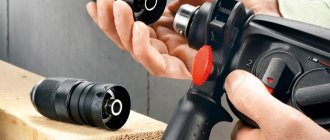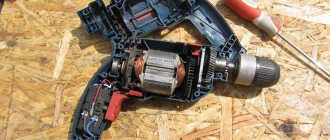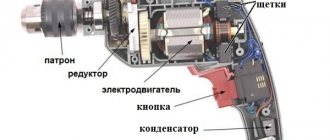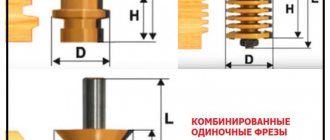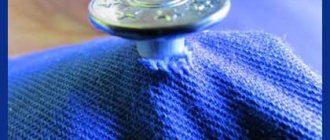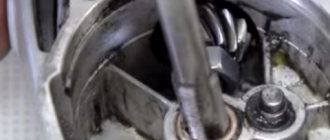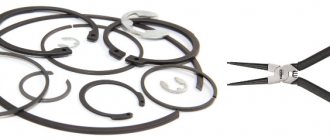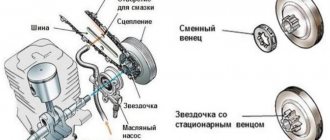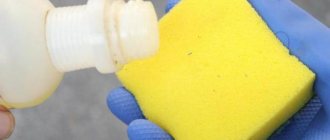How to remove a retaining ring: technology and tools: types, techniques, characteristics
What is a snap ring
Due to the similar name and shape of the ring, many people confuse a snap ring with a lock washer. Despite the similarity in name and appearance, they have fundamentally different functions. A lock washer secures a threaded connection by preventing rotation of the nut or bolt head. A locking ring prevents axial movement of a bearing, shaft, axis of rotation or other structural element.
Retaining rings are made of high-quality spring steel; it has a narrow through cut and two areas along its edges, which are called ears. There are holes made in the platforms, by taking which, the cut can be reduced or enlarged. This changes the circumference of the product. On the mechanism parts that need to be secured against axial movement, a narrow shaft is machined or milled, slightly wider than the height of the ring. The ring, in a compressed or stretched state, is inserted into the groove and released. The part is compressed, enveloping the shaft, or expanded, fixing the bearing in the hole. To remove the fastener, you also need to unclench or close the ears.
Ring locking fasteners are widely used in all branches of mechanical engineering, from watchmaking to mining equipment, from paper machines to bicycles, from household appliances to spacecraft.
What methods of installing split washers are known and how to remove them
There are three options for installing split washers:
- Manual is the most popular, which is used by craftsmen when repairing cars, motorcycles, bicycles and other types of equipment.
- Mechanical - based on the use of a mounting cone, which has the same diameter as the shaft. Using a special pusher, the part moves along the cone until it falls into the groove
- Automatic - installation and removal of rings is carried out using specialized hydraulic and pneumatic tools
Like most parts, retaining rings can fail. If after dismantling the part there is a loss of spring properties, it is recommended to replace it. Even if you manage to install it in its place, this does not mean that it will not fail in the process.
Removing the retaining rings
Removing locking split washers is carried out using two main methods:
- With partial disassembly of the main mechanism. In this case, the assembly containing the ring is dismantled. It is fixed in a vice or other clamping device on the workbench, and the part can be removed in the comfortable conditions of a warm and well-lit workshop.
- No partial disassembly. The unit to be repaired is not dismantled; its disassembly and replacement of parts occurs in less convenient conditions, conceived in the open air.
In both cases, it is better to remove the locking part using special pullers that match the type and size of the locking fastener.
Read also: Drilling holes in metal
If for some reason they are not at hand, craftsmen adapt one or another universal tool or modify it by making a puller with their own hands. This approach may be justified if you urgently need to remove one or two rings. For large volumes of work, factory-made pullers demonstrate their superiority in a number of ways:
- strength;
- reliability;
- convenience and speed of work;
- safety.
Experienced craftsmen have formulated a number of recommendations on how to remove the lock washer from the front suspension wheel bearing:
- The rack is removed from the car and clamped in a vice.
- The hub is knocked out with a hammer.
- Lightly tapping the side of the inner retaining ring with a small hammer loosens its contact with the groove.
- Next, using a suitable type and size ring remover, you need to remove the ring mount. In the absence of a standard tool, some craftsmen manage to remove the stopper with two thin screwdrivers.
- After pressing out and replacing the bearing, you need to check its position: the front end must be at the level of the far wall of the groove for installing the locking part.
- The ring is compressed with a puller and brought to the groove. After alignment along the entire perimeter, the handles are gradually loosened and the part falls into place.
Recommendations on how to remove the rear wheel bearing and its retaining ring are as follows:
Remove the wheel and brake drum. Using a flat-head screwdriver, carefully pry up and remove the oil seal. Remove the ring from the inner diameter with a puller of suitable size and type. Remove the inner race of the bearing. Knock out the outer ring by lightly tapping it on the beard and remove it.
After lubricating or replacing the bearing, reassemble the assembly in the reverse order.
Making a puller from old pliers
If you have broken pliers or pliers in your arsenal of tools, then you can use them to make a full-fledged puller. To make it you will need tools such as a grinder, a welding machine and a sharpening machine. Before you get started, it should be noted that you can use unnecessary pliers to make pliers for removing and installing external snap rings. The manufacturing instructions look like this:
- Initially, we cut off part of the jaws on the tool so as to align them
- After this, we prepare the tips for the future puller. We will make them from bolts or studs with nuts
- The threaded part of a bolt or stud is ground on a sharpening machine to form a cone
- Finished tips must be welded with the side of the cap to the pliers
- After this, we calcinate the tips so that when removing or installing retaining rings, we eliminate the possibility of damage to them.
- We remove the weld seams, and you can test the tool in action.
The resulting do-it-yourself puller for removing and installing split rings will please the craftsman when it is necessary to use it. After all, the main advantage of this tool is that it is made by hand, and instead of disposing of broken pliers, they can serve for a long time and effectively.
In conclusion, it should be noted that removing the retaining rings is not difficult if you have knowledge of the principle of operation of a specialized tool. Some craftsmen resort to dismantling rings using nails and other improvised means, but these methods are not only ineffective, but also dangerous. If you don’t want to buy new pullers, then make them yourself, which is not difficult to implement.
source
What does the retaining ring look like?
Many people mistakenly confuse a lock washer with a lock ring due to the name and round shape. However, in reality, there is a big difference between these two products. First of all, the retaining ring is an open circle, meaning there is a small opening in it. In addition, the locking ring has special lugs, with the help of which the part is securely fixed in the structure, since the lugs act as a shoulder, that is, a lever.
Production of retaining rings
The production of retaining rings implies strict compliance with all standards established by GOST 13940-86, GOST 13942-86 or DIN 471 for external rings, as well as GOST 13941-86, GOST 13943-86 and the European analogue of DIN 472 for internal rings. According to the requirements of these standards, the materials for the manufacture of these products are carbon steel 65G, structural steel 60C2A, heat-resistant steel 40X13 and other grades.
For the production of retaining rings, steel sheets and strips are usually used; less often, they are made from round or oval wire. Rings are manufactured with a rectangular cross-section by default, but in some cases, at the request of the customer, their production can be carried out according to a given drawing. All steel blanks must undergo additional heat treatment. Their surface is treated using one of the following coatings:
- zinc
- cadmium
- phosphate
- oxide
Types of retaining rings
Retaining rings are selected for a specific unit of a certain mechanism based on the operating conditions and design features of the product. For example, external locking rings are used to secure elements on a shaft. To fix different products directly in the hole itself, internal locking rings are used. Types of retaining rings differ in the direction of the lugs: on external ones they are directed outward, on internal ones they are directed inward.
Application of retaining rings
The use of retaining rings in industry can be observed in almost all production areas where various mechanisms are involved. They are especially often found in mechanical engineering, shipbuilding, aircraft manufacturing, carriage building, machine tool building and similar industries. Such products can be installed in gearboxes, motors and other elements that rotate on their own axes and require very reliable fixation.
Circlip Pliers
Retaining rings are a fairly common type of fastener used in the automotive industry and other areas of light and heavy industry.
They are usually designed to secure parts to shafts or holes of other parts. They are distinguished into external and internal, in accordance with the method of fastening.
For example, external ones are installed directly on the shaft, and internal ones - on holes.
This is not entirely correct from the point of view of terminology, since the device is a forceps. Currently, manufacturers offer a wide range of such tools; we will analyze the pros and cons of each type and tell you about the most interesting models.
We hope this information will help you choose and buy a circlip puller that will be most convenient for solving your problems.
Design and features of retaining ring pullers
So, lock ring pullers are a type of pliers tool. They have a classic design - two handles with jaws are connected to each other using a hinge joint. Their key difference is the execution of the working profile.
The jaws of the tool are tips that are inserted into the grooves of the rings. Moreover, they may differ from each other in certain design features. The most common types are:
- Retaining ring pullers are of the so-called “Japanese type”, which are characterized by extremely high strength. The jaws of the tool have a pointed shape with notches. Objectively about the disadvantages of this type: in rare cases, the tips may not be securely fixed in the groove.
- The “European type” has a special chamfer at the end of the working part, due to which a decent fixation of the ring is achieved. The main disadvantage of the Eurotype is that this design significantly weakens the tip, which leads to less durability of the tool.
- There are also circlip pullers with pressed-in carbide steel tips. Such devices do not have the disadvantages described above, however, their price is significantly higher than the cost of the two previous types.
Classification of retaining ring pullers and their characteristics
Key features of the circlip pliers include:
- Jaw grip range.
- Length of handles. Determines the force that the tool can transmit. The longer the handles are, the more force the pliers can exert on the rings.
- Material of manufacture. Directly affects the strength characteristics of the device. We recommend pliers made from reinforced alloys such as chrome vanadium.
As for classification, all snap ring pliers are divided into two types: compression and release. The shape of the tip also matters - it can be straight or curved. Thus, all pullers can be classified into four types:
- Direct compression (for internal).
- Direct release (for external ones).
- Curved for internal ones.
- Curved for external ones.
Sets and universal circlip pullers with replaceable jaws
To achieve the greatest efficiency and for comfortable work with different types of rings, it is best to buy a set of circlip pullers or a universal device with replaceable jaws:
- Sets.
In this case, the user receives four pairs of pliers with different types of tips (curved and straight) for both outer and inner rings. - Universal devices.
Various jaws can be installed on the handles of such pullers - straight or curved, working for compression or expansion.
We recommend paying attention to the most advanced and functional models, such as the universal circlip puller Licota ATB-0100. They have unique advantages, including:
- Switching the compression mode to the release mode is carried out using a special lever, thereby increasing the operating speed.
- The kit includes interchangeable jaws to allow the puller to remove and install different sizes of circlips.
- The tips of the pliers can be adjusted and fixed in any position from 0 to 180 degrees, due to which the device can be used in the most inconvenient and difficult to reach places.
Tool selection criteria
The correct choice is influenced by the approach, so you need to take into account a number of the following recommendations:
- If you plan to carry out long-term and serious work on repairing automotive equipment, it is recommended to buy a set of round nose pliers, which should consist of at least 4 copies
- For isolated cases of removing and installing rings, round nose pliers of the appropriate parameters are suitable
- The size of the jaws and handles affects the ability to access parts located in remote places. The length of the handles affects such a parameter as the ease of use of the tool
- Type of device - for external or internal clamps
- Availability of coating on the handles. This coating should not be smooth to prevent the tool from slipping in your hands. Expensive models have a coating on the handles, consisting of two components - plastic and silicone, rubber and silicone, etc.
- The presence of a protective anti-corrosion coating on the jaws of the tool - the absence of this coating will soon lead to the fact that the metal parts will begin to become covered with a rusty coating. As a result, this will lead to accelerated failure of the specialized tool.
- Type of release mechanism. What they are is described above, but which is the best - there is no consensus. All types of spring mechanisms perform their functions perfectly if they are made of high-quality materials
- The thickness of the jaws depends on the diameter that you plan to remove and install. If you don’t know the diameters, it’s better to buy universal pliers
- The shape of the sponges is straight or curved. There are two types of tools in shape, and if the device being fixed is located in a hard-to-reach place, then round pliers with bent jaws are better suited for such purposes
What does the retaining ring look like?
Many people mistakenly confuse a lock washer with a lock ring due to the name and round shape. However, in reality, there is a big difference between these two products. First of all, the retaining ring is an open circle, meaning there is a small opening in it. In addition, the locking ring has special lugs, with the help of which the part is securely fixed in the structure, since the lugs act as a shoulder, that is, a lever.
Production of retaining rings
The production of retaining rings implies strict compliance with all standards established by GOST 13940-86, GOST 13942-86 or DIN 471 for external rings, as well as GOST 13941-86, GOST 13943-86 and the European analogue of DIN 472 for internal rings. According to the requirements of these standards, the materials for the manufacture of these products are carbon steel 65G, structural steel 60C2A, heat-resistant steel 40X13 and other grades.
For the production of retaining rings, steel sheets and strips are usually used; less often, they are made from round or oval wire. Rings are manufactured with a rectangular cross-section by default, but in some cases, at the request of the customer, their production can be carried out according to a given drawing. All steel blanks must undergo additional heat treatment. Their surface is treated using one of the following coatings:
- zinc
- cadmium
- phosphate
- oxide
Types of retaining rings
Retaining rings are selected for a specific unit of a certain mechanism based on the operating conditions and design features of the product. For example, external locking rings are used to secure elements on a shaft. To fix different products directly in the hole itself, internal locking rings are used. Types of retaining rings differ in the direction of the lugs: on external ones they are directed outward, on internal ones they are directed inward.
Application of retaining rings
The use of retaining rings in industry can be observed in almost all production areas where various mechanisms are involved. They are especially often found in mechanical engineering, shipbuilding, aircraft manufacturing, carriage building, machine tool building and similar industries. Such products can be installed in gearboxes, motors and other elements that rotate on their own axes and require very reliable fixation.
DIY tool for removing circlips
Many people have probably had occasions when they needed to unscrew a screw with a non-standard head, remove/put on a part in a hard-to-reach place, etc. and so on. In general, the review is devoted to just such a specific tool, the need for which arises no more than once a year, but when it is needed, it is better if it is there. For those interested, take a look under the “cut”
Once I needed to replace the mowing reel for the trimmer - the old one “died”. Well, of course, I have a screwdriver and hands. I unscrewed what was unscrewed, took off what was removed... And here’s the ambush.
In the depths of the Siberian shaft there is a retaining ring, the removal of which takes quite a long time without a special tool.
With the help of 2 nails, a flat-head screwdriver, I took off this ring about the 20th time (it’s much easier to put it on), but when I came across “or” this product, I decided to buy it, fortunately the price was not high, and the Welcomeback_User_Coupon_Oct_R1_2_1 coupon for $2 came in handy.
After 3 days, the seller provided me with a tracking number, and after 16 days I received a parcel.
The pliers are packaged in a blister, on the back of which there is an instruction manual.
The kit includes additional attachments at 45° and 90° for various “situations”. The pliers are universal - they work both for expanding (to remove the locking ring from the shaft) and for compressing (if it sits inside the tube).
Simply press the central spring-loaded pin, pull out the “lock”, pull it out, and then put the attachment on the other side of the pliers onto the pins and lock it again. Voila! In this way, the principle “there is no extra tool in the house” is observed, and the next time you replace the coil, when it falls apart again, 20 minutes of time and a lot of nerves will be saved.
Well, of course, I didn’t buy these pliers just to repair the trimmer; there are rings in many tools that sooner or later will have to be disassembled/lubricated/repaired.
Retaining rings are widely used in the designs of a wide variety of mechanisms to secure a shaft, rod, axis of rotation or bearing. They are used in water valves and gearboxes, in ship gearboxes and in space stations. If it is necessary to replace or repair a mechanism assembly, the ring must be removed. For this purpose, special tools are used - ring removers.
What is a snap ring
Due to the similar name and shape of the ring, many people confuse a locking ring with a lock washer. Despite the similarity in name and appearance, they have fundamentally different functions.
A lock washer secures a threaded connection by preventing rotation of the nut or bolt head.
A locking ring prevents axial movement of a bearing, shaft, axis of rotation or other structural element.
On the mechanism parts that need to be secured against axial movement, a narrow shaft is machined or milled, slightly wider than the height of the ring. The ring, in a compressed or stretched state, is inserted into the groove and released. The part is compressed, enveloping the shaft, or expanded, fixing the bearing in the hole.
To remove the fastener, you also need to unclench or close the ears.
Ring locking fasteners are widely used in all branches of mechanical engineering, from watchmaking to mining equipment, from paper machines to bicycles, from household appliances to spacecraft.
Types of retaining rings
There are two main types of locking ring connections:
- Internal. Serve to fix parts inside holes. Used for fastening bearings. The ears protrude inward. To install them, you need to compress them so that the length of the outer circumference decreases, insert the part into the inner groove and release the ears. The part will straighten and partially fall into the groove, and partially protrude from it. This protruding part will not allow the bearing resting against it to move in the axial direction. To remove the mount, the ears need to be spread apart.
- External. Used for fastening parts on shafts, axles, rods. They are put on the shaft from the outside, the ears protrude on the outer side of the product, the cut between them is minimal. For installation, the ears are moved apart, the length of the inner circumference of the product increases, and it can be put on a shaft or axle, placed in a machined groove. After this, the ears are released, the part is compressed under the influence of elastic forces, fits tightly into the groove, leaving an annular rim on the outside. It will not allow the part to move in the axial direction. To remove such a part, the ears are brought together.
Where to buy tongs
Carrying out work without a specialized tool is strictly contraindicated, as it is dangerous, so you can buy round nose pliers for removing retaining rings in the Cylinder online store. There are many different models of tools from different manufacturers - Intertool, Mastertool, Sila and others. The store presents models both in single copies and in sets of 4 pieces. To simplify your selection, you can use a filter to sort your preferred models automatically.
The cost of models starts from 40 hryvnia, so everyone can decide which tool is right for them - cheap or expensive. When choosing or purchasing, you can ask questions to store managers, clarifying unclear nuances. The online store offers fast collection of orders, as well as shipping them on the day of purchase. You can receive your order using any transport services in Ukraine. When purchasing in Cylinder, depending on the cost of the product, instant bonuses are credited to the buyer’s account. Each customer can spend these bonuses along with the purchase of the main product, which is clearly a unique and pleasant advantage.
The Cylinder online store offers models of pliers of different lengths from 150 mm to 180 mm. Knowing about all the design features of pliers for retaining rings, as well as their selection and types, all that remains is to compare the appropriate models depending on the work performed, and make a purchase in Cylinder.
Retaining ring pullers and their main characteristics
Like all tools, pullers have their own basic characteristics, which will be useful to know about for those who are planning to purchase these devices.
- The size of the jaws is one of the most important parameters that determines the ability of the tool to work with fasteners located in recesses and hard-to-reach places. The longer the jaws of the tool, the less force is required to compress or unclench the locking ring when removing or installing it. Dimensions are indicated directly on the tool itself
- Length of handles - the larger the size of the handles, the more convenient it is to use the tool
- Jaw shape - there are pullers available with straight tips and those bent at an angle of 90 degrees. If straight lines are used to access distantly located rings, then curved ones are used when working in hard-to-reach places
- The diameter or thickness of the jaws - they must be commensurate with the size of the holes on the ears of the parts. If the tool is not designed to remove thin or thick split washers, you should not attempt to use it. This can lead to either one of the jaws on the puller breaking off or damage to the lugs on the retaining ring.
- Jaw reverse bending function - this mechanism is used on external type pullers designed to work with external locking rings, operating in the unclamping mode
The most popular puller options are universal models. They allow you not only to use jaws of different lengths and thicknesses by replacing them on the tool, but also to work with different types of locking rings (internal and external). The advantages of universal pullers include their cost, since one tool costs less than a whole set. Most models are equipped with force limiting mechanisms, which eliminates the possibility of damage to thin parts.
When using universal pullers, it is important to use tips from identical pairs. Their difference in length or diameter will lead to negative consequences
During removal or installation, a part may slip out and hit a person or equipment.
This is interesting!
The disadvantage of universal pullers is that high-quality materials are not always used for their manufacture. If you are planning to purchase a universal tool, then you need to choose from models from well-known brands TopTul , Jonnesway and others.
What are round nose pliers made of?
When conducting a detailed analysis of pullers, you also need to know about what the devices are made of. Round nose pliers are a highly specialized tool, and apart from working with locking elements, they are not used anywhere else. To ensure high performance and reliability when working with parts, manufacturers manufacture them from special high-strength steels. For manufacturing, tool alloy steel is used, the hardness of which reaches 58 HRC Rockwell. However, not all manufacturers produce tools with such parameters. To purchase a quality puller, you need to find out all the technical features before purchasing it.
The cone-shaped jaws are made directly from tool steel, and the rest of the part (connecting and handles) is cast from ordinary steel. For ease of use of the tool, the handles are covered with plastic, rubber or silicone, which prevents slipping in the hands. Another important element of the tool in question is the spring mechanism. Depending on the models and manufacturers, spring mechanisms can be presented in the form of the following elements:
- Conventional cylindrical spring
- Steel wire with turns
- Steel plates
Retaining rings with tendrils are evil.
I don’t know, maybe this problem has already been described, but I couldn’t find it in a search. I came across it for the first time. Briefly, what happened.. At the time of analysis, the piston had driven approximately 10 thousand. For the last 3-4 thousand, the engine smoked when adding gas, after braking the engine. At first it didn’t smoke much, but in the end the smoke poured out like from a samovar... An autopsy showed...
For some time I thought about how to solve the problem. Once upon a time I used fluoroplastic fungi - plugs. I've driven quite a lot, more than 10 thousand, and no problems have been noticed with them. By searching, I found a topic describing the problem of shrinking such traffic jams. Most likely in this case the material was different.
Now I decided to do it differently. By the way, whoever wants to redo it in this way - in this case it is advisable to use fingers without chamfers, with flat ends.
ps Today we opened the Sachs MadAss 125 engine (a Chinese copy of the Honda Super Cub engine) and found this cocktail... It’s not clear why they left the tendril if the groove for removing the stopper had already been cut? The Chinese in a word...
Instructions on how to remove a lock washer from the front suspension of a car using pliers
When replacing a wheel bearing on a car, you cannot do without round nose pliers, which will be needed to remove the slotted lock washer. The process looks like this:
- It is necessary to begin removing the wheel bearing only after the CV joint has been removed from the steering knuckle
- When the steering knuckle is ready to replace the bearing, you need to pick up a tool of a suitable size - pliers
- To dismantle the retaining ring, you will need compression pliers, since the bearing is fixed using an external device
- The jaws of the tool must be engaged with the holes in the ears of the part.
- Press down on the tool handle, and when the washer is sufficiently loosened, it is necessary to remove it from the hub seat
- Next, you need to remove the bearing, and after replacing it, reinstall the fixing part
- The fixing device must be replaced if there is wear or obvious signs of deformation, for example, chips, distortions, cracks, missing ears, etc.
Some craftsmen, in the absence of special pliers, try to remove the fixing part with improvised means, using pliers, cleats, a screwdriver, etc. Everything ends unsuccessfully, and sometimes even with injuries. The ring has spring properties, so when removing it it must be held in a rigidly fixed position. If you try to remove it using improvised means, you can get injured, damage the part, waste a lot of time, and not achieve results.
This is interesting! To prevent serious injuries that may occur when the locking ring pops out, work must be carried out wearing safety glasses, gloves, and even a mask. The force of the part being bounced is so great that it can cause serious head injury.
Where are the split washers located and when will the use of pullers be needed?
Today there are a lot of mechanisms in which retaining rings are found. As mentioned above, they come in different types, but perform one function - they eliminate axial movement. Split washers are found quite often, and here are the main places where they are used:
- CV joints
- Car starter
- Half shafts
- Grenades
- Wheel bearings
- Door handles
- Pistons
- Hydraulic cylinder rods
- Screwdrivers, drills and hammer drills
- Turbines
The door handles use small parts, and the axle shafts have large devices. To dismantle certain products, you will need to use appropriate pullers. There are split washers that do not have ears with holes. These devices are found on automobile pistons and other types of equipment. Pliers are not suitable for removing and installing such rings. Their installation and dismantling is carried out using a screwdriver. The video below shows how to remove and replace the piston retaining ring using a screwdriver.
Bendix replacement
Regardless of whether you are going to replace the bendix or rebuild it, you will first have to remove it from the starter. There are two types of starters:
- With a “beak”, where the front support of the starter shaft is made in its housing.
- And without the “beak” where the front starter support bushing sits in the crankcase.
The most common mechanisms are of the first type, the “beakless” ones are familiar from the VAZ of the “eighth” family.
Since you can change the Bendix on the starter only by removing the starter itself, first the battery ground is disconnected, and the power cable and the solenoid relay control wire are removed from the starter. Having unscrewed the fastenings of the starter to the crankcase, we pull it out.
Read more: Hand position on the steering wheel and character
Regardless of the design of the starter, the solenoid relay is first removed, since its plug later interferes. We unscrew the nut on the power terminal of the starter winding, remove the terminal, then unscrew the screws connecting the retractor to the housing. We take out the relay winding, after which the core can be easily disengaged from the Bendix fork.
Then we disassemble the starter. Having unscrewed the longitudinal coupling bolts of the covers, remove the “beak” or front cover of the starter. After this, you can easily remove the fork from the Bendix and pull the rotor towards you.
A thrust bushing is installed on the rotor, limiting the stroke of the bendix. Before removing the bendix from the starter, you need to compress this bushing. In garage conditions, an open-end wrench is used, the mouth of which fits onto the rotor shaft, but rests against the bushing with its jaws. Having firmly fixed the key in a vice, we rest the thrust sleeve against its jaws and apply a sharp blow to the end of the shaft through a drift made of durable wood, copper or aluminum, so as not to damage the shaft itself. After this, the retaining ring installed inside the bushing jumps off the groove and releases it. After removing the bushing, pull the retaining ring off the shaft by prying it off with a thin screwdriver.
After this, we take out the Bendix assembly. Installing the Bendix is done in the reverse order, and the main difficulties are caused by pressing the thrust bushing back. It should be taken into account that it is asymmetrical - on one side there is a wide chamfer, which makes it easier to enter the locking ring. When removing the bushing, the retaining ring is deformed; it must be straightened before assembly. The thrust bushing must be seated on the retaining ring without distortion, otherwise the edge may be squeezed out of the groove on the rotor, the ring will bend and will not allow the thrust bushing to be pressed into place.
Something else useful for you:
Characteristics of circlip pullers
In order to look at the full variety of ring remover models offered by domestic and foreign manufacturers, it is advisable to know the important parameters characterizing these devices. These include:
- Jaw length. This parameter determines the ability of the puller to work with fasteners located in depressions and other hard-to-reach places. It must be remembered that as the jaws lengthen, according to the law of leverage, the compression force decreases (with equal force on the handles)
- Length of handles. Affects the ease of use and the maximum force of compression or expansion of the lugs.
- Tip shape. Both straight and curved at a certain angle (from 0 to 90°) are used. Straight ones make it possible to develop greater force, curved ones are more convenient when working in depressions.
- Diameter of tips. Should be, if possible, closer to the diameter of the holes in the ears. A very thick tip simply will not fit into the hole, and a very thin tip will most likely not withstand the load and break. Moreover, the ring may slip off from thin tips.
- Reverse bending of tips. Used on external pullers to open the ears. The bend increases the reliability of holding the ring.
Such characteristics of circlip pullers are relevant for classic designs. Multifunctional pullers are available on the market. Their sponge tips are made removable; they can be quickly removed and replaced with another, much better pair for the occasion. The selector switches the expansion/compression modes, an additional hinge makes it possible to change the inclined angle of the jaws from 0 to 90°.
Many models are equipped with a force limiter. This makes it possible to adjust the maximum opening or closing force without damaging the thin rings.
When using multifunctional pullers, you need to be careful when selecting tips. It is allowed to use only those tips that are made by the same manufacturer or are indicated by them as compatible.
The combined use of tips from different pairs that differ in length, oblique angle or reverse bend is absolutely unacceptable. This will damage the device. Another unpleasant consequence is that the fastener part may fall off the jaws and go off into wild flight. Because metal, when compressed or decompressed, stores a lot of energy, damage to workshop equipment or serious injury to people is possible.
When working with ring fasteners and pullers, first of all use personal protective equipment - unbreakable work glasses (face shield) and protective gloves.

